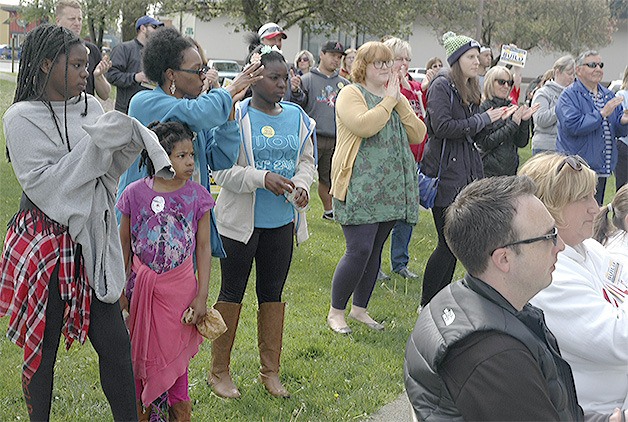BY KIRK BOXLEITNER
and STEVE POWELL
spowell@marysvilleglobe.com
MARYSVILLE – Every school, and therefore every student, will benefit from the $230 million bond election that is on the April 26 ballot.
Emily Wicks, a spokeswoman for the Marysville School District, reminded voters of that at the April 18 school board meeting.
Earlier in the week, a rally in support of the bond measure took place at Comeford Park downtown, with a number of local leaders speaking in support of the effort.
But at the school board meeting, Wicks said it is true the oldest schools would be replaced: Cascade and Liberty elementaries, Marysville and Totem middle schools, and Marysville-Pilchuck High School.
But she said every school will receive some type of fix. Some schools need upgrades in heating. Others need a new roof. Others need more space for things such as loading buses. Others just need to get rid of portables for safety and other reasons.
Safety is a concern everywhere, especially considering the tragedy at M-P in 2014. Security updates with intercoms and fire alarms are planned.
Wicks mentioned that a new middle school planned west of Strawberry Fields in north Marysville would save the district in transportation costs, adding that many students ride a bus 45 minutes or more. She added that Totem students would be moved to the Arts and Tech High School building when the new school is built. Students at A&T would be going to their own campus at the new M-P.
As for a timeline, M-P would be done first, followed by MMS, the new middle school, Cascade, Liberty and the upgrades.
If the bonds are approved Tuesday, the state would pitch in $62.4 million of the cost. On a $280,000 home, which is the average in town, taxes for this would be $320 a year.
Hicks then showed a short movie clip. In it, principals Gloria Henderson of Liberty and Angela Hanson of MMS spoke.
Henderson said passing the bond would help students feel like the community cares about them.
“They want more for me,” she said of the kids.
Hanson said new schools would make the students feel proud.
“This is our future. Invest in it now,” she said.
Comeford Park rally
At the rally, Henderson said the bonds mean giving “her kids” a greater level of pride and investment in their learning environment.
“A lot of our families are already struggling with poverty at home,” she said. “Then their children have to come to a really old school building.”
Henderson sees the removal of her school’s portables as not just an aesthetic enhancement, but also a safety measure, to discourage the homeless from camping out under them.
“When you’re having a hard time making ends meet, it helps to have the hope of a bright, renewed school,” Henderson said.
Marysville City Councilman Michael Stevens asserted that the bond measure has “the right people in the right seats on the right bus in the right direction at the right time” to pass.
“Marysville’s heyday is not in the past,” Stevens said. “It hasn’t happened yet. We’re creating it, through measures like this. Our schools are not just schools. They’re neighborhood centers. They’re where our cultural events take place.”
Tulalip Tribal Chairman Mel Sheldon Jr. recalled how many tribal members have attended Marysville schools, including his father.
“Tulalip believes in the Marysville School District,” Sheldon said. “If you care about the future, now is the time to make a difference. The education and resources we provide for our kids will continue to make a difference for generations that haven’t even been born yet.”
State Rep. June Robinson, D-Everett, echoed Stevens’ idea that, by building schools, Marysville was building its community.
“As a mom, I feel anguish about the world I’m leaving behind to my kids,” Robinson said. “What we’re doing here is an antidote to the bad things. Our state has an investment in our schools, but they cannot succeed without local community investment as well. We need to rally around our kids.”
Marysville School Board President Pete Lundberg first arrived in the district in 1985, and was heartened from the start by the confidence that citizens had in their schools.
“What I heard from them was, ‘If the district doesn’t need it, they don’t spend it,’” Lundberg said. “This is something we do need, for our community, our economy, and equity for all our kids. So many of our poorest students go to our oldest schools. We need to send a message that opportunity is available right here.”



